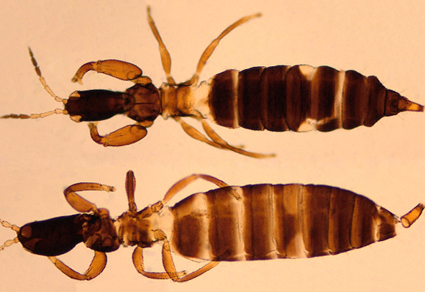Abstract
Species of Compsothrips are ant-mimics in body form and structure. In contrast to the predatory species of ant-mimicking Aeolothripidae, these species feed by ingesting fungal spores. Worldwide, there are 27 species listed in this genus, with three recorded here from China. Compsothrips tenebronus is here considered a new synonym of C. sinensis, and C. timur is newly recorded from China in Tibet. Furthermore, C. reticulates is redescribed, with details of the female given for the first time. An illustrated key is provided to the three species of Compsothrips from China.
References
- Ananthakrishnan, T.N. (1964) A contribution to our knowledge of the Tubulifera (Thysanoptera) from India. Opuscula Entomologica, 25 (Supplement), 1–120.
- Dang, L.H., Mound, L.A. & Qiao, G.X. (2013) New records and nomenclatural changes among spore-feeding thrips from China (Thysanoptera, Phlaeothripidae, Idolothripinae). Acta Zootaxonomica Sinica, 38 (3), 657–660.
- Dang, L.H. & Qiao, G.X. (2013) Review of the spore-feeding Idolothripinae from China (Thysanoptera, Phlaeothripidae). Zookeys, 345, 1–28. https://doi.org/10.3897/zookeys.345.6167
- Dang, L.H., Zhao, L.P., Li, Y.Q. & Wang, X. (2021) Bolothrips bicolor (Heeger) (Thysanoptera: Idolothripinae): a genus and species newly recorded from China. Zoological Systematics, 46 (3), 264–268. https://doi.org/10.11865/zs.2021308
- Faure, J.C. (1949) Three remarkable new genera of Phlaeothripidae (Thysanoptera) from South Africa. Union of South Africa, Department of Agriculture, Entomology Memoirs, 2, 203–217.
- Guo, F.Z. & Feng, J.N. (2006) A new species of the genus Compsothrips Reuter (Thysanoptera, Phlaeothripidae) from China. Acta Zootaxonomica Sinica, 31, 843–845.
- Hakimara, M., Minaei, K., Sadeghi, S. & Mound, L.A. (2019) Fungus-feeding thrips in Iran with a new species of Stictothrips (Thysanoptera: Phlaeothripidae. Zootaxa, 4652 (3), 557–567. https://doi.org/10.11646/zootaxa.4652.3.11
- Han, Y.F. & Cui, Y.Q. (1991) Three new species of Thysanoptera (Insecta) from the Hengduan Mountains, China. Entomotaxonomia, 13 (1), 1–7.
- Li, Y.Q., Zhao, L.P., Li, C.W. & Dang, L.H. (2022) Review of the genus Ophthalmothrips Hood (Thysanoptera:Phlaeothripidae) from China, with a new species. Zoological Systematics, 47 (4), 305–312.
- DOI: 10.11865/zs.2022403
- Mound, L.A. & Marullo, R. (1998) Biology and identification of Aeolothripidae (Thysanoptera) in Australia. Invertebrate Taxonomy, 12, 929–950. https://doi.org/10.1071/IT97014
- Mound, L.A. & Palmer, J.M. (1983) The generic and tribal classification of spore-feeding Thysanoptefra (Phlaeothripidae: Idolothripinae). Bulletin of the British Museum (Natural History) Entomology, 46, 1–174.
- Mound, L.A. & Reynaud, P. (2005) Franklinothrips; a pantropical Thysanoptera genus of ant-mimicking obligate predators (Aeolothripidae). Zootaxa, 864 (1), 1–16. https://doi.org/10.11646/zootaxa.864.1.1
- Pelikan, J. (1961) Two new species of Oedaleothrips from Asia. Časopis Československé Společnosti Entomologické (Acta Societatis Entomologicae Cechosloveniae), 58, 302–309.
- Priesner, H. (1928) Thysanopterologica III. Zoologisches Jahrbucher, 56, 43–66.
- Reuter, O.M. (1901) Thysanoptera tria Mediterranea. Öffersigt af Finska Vetenskaps-Societetens Förhandlingar, 43, 214–215.
- Stannard, L.J. (1976) A synopsis of some ant-mimicking thrips, with special reference to the American fauna (Thysanoptera: Phlaeothripidae: Idolothripinae). Journal of the Kansas entomological Society, 49, 492–508.
- ThripsWiki (2023) ThripsWiki—providing information on the World’s thrips. http://thrips.info/wiki/Main_Page (accessed 10 August 2023)
- Wang, Z.H., Mound, L.A., Hussain, M., Arthurs, S.P. & Mao, R.Q. (2022) Thysanoptera as predators: their diversity and significance as biological control agents. Pest Management Science, 1–14. https://doi.org/10.1002/ps.7176
- Zhang, W.T., Feng, J.N., Cao, S.J. & Guo, F.Z. (2017) The spore-feeding genus Nesothrips (Thysanoptera: Idolothripinae) from China, with one new record. Entomotaxonomia, 39 (4), 314–319. [ISSN 2095–8609] https://doi.org/10.11680/entomotax.2017038


